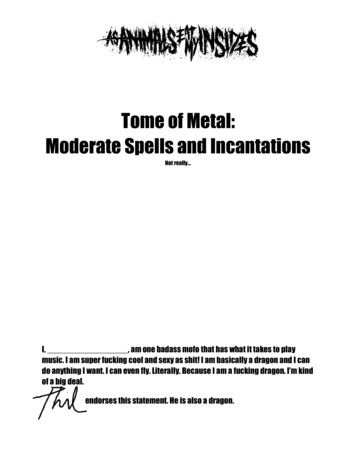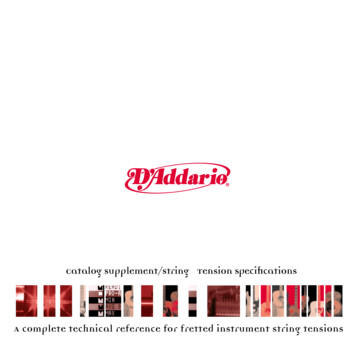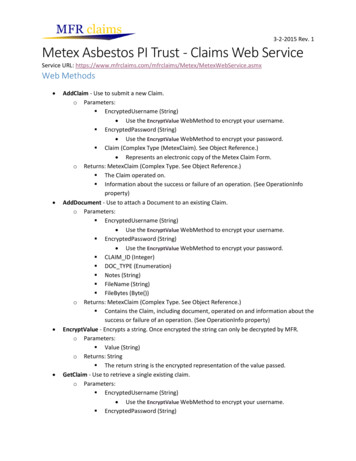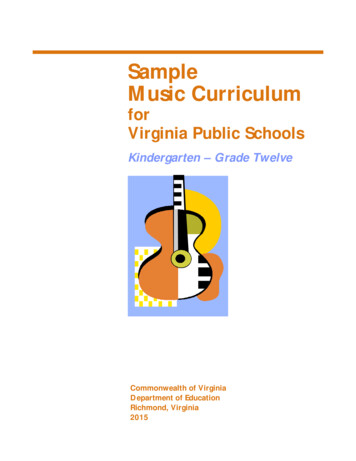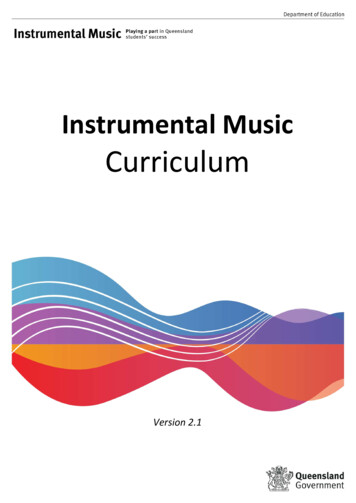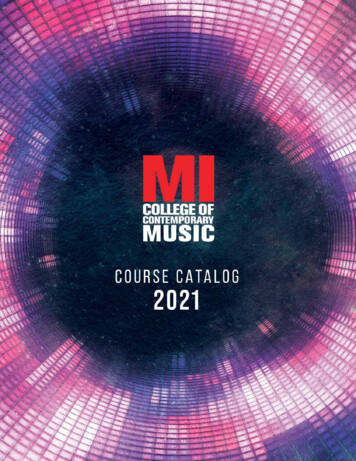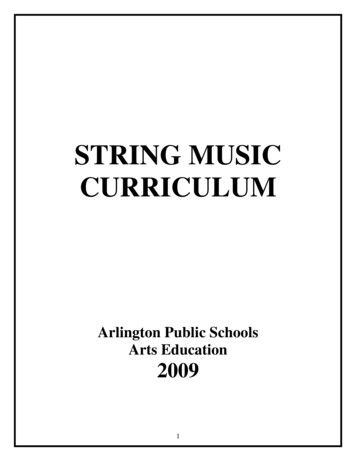
Transcription
STRING MUSICCURRICULUMArlington Public SchoolsArts Education20091
This string curriculum was developed by:Serena EverettGene PohlEstelle RothKristin SnyderCarol ErionAugust 20082
GRADE 4-5VBODA LEVEL IESSENTIAL ELEMENTS – BOOK 1BASIC SKILLSStudents will begin instruction on a string instrument of their choice. Instruction begins grade 4 andcontinues until the skill levels are mastered. Students will demonstrate proper care of theinstrument, basic positions, tone production, fingerings, and will count, read, and perform thebeginning level of music being studied. Teachers will use available standard method books todeliver instruction with limited ensemble work.PERFORMANCEBS.1Demonstrate correct posture and playing position.1. standing and sitting posture2. consistently correct instrument position3. left-hand shape4. consistently correct bow holda. thumb between frog and gripb. thumb opposite middle fingerc. forefinger, middle, and ring fingers draped over bowd. pinkie and thumb rounded and on their tipsBS.2The student will consistently produce tones that are clear, free of tension,sustained, and unwavering in pitch:1. demonstrate right-hand pizzicato over the fingerboard2. demonstrate the ability to draw a straight bow at the proper contact point betweenthe bridge and the fingerboard using an even bow speedBS.3The student will demonstrate the ability to adjust pitches while playingtheir instrument.BS.4The student will demonstrate a steady tempo while performing materialsbeing studied.BS.5aThe student will use contrasting articulation: detache, pizzicato, slurringBS.5bThe student will demonstrate accurate execution of down bow, up bow,legato bowing, smooth string crossings, bow lifts, two-note slurs, and ties.BS.6The student will perform selected one-octave major scales using simplebowings and rhythmic figures, ascending and descending:1st Year:G, D2nd Year:C, G, D, F3
BS.7The student will perform rhythmic patterns using whole, half, quarter,eighth, dotted half, dotted quarter, and corresponding rests whilemaintaining a steady, rhythmic pulse.BS.8The student will use dynamic contrast as a means of expression:1. p and fBS.9The student will demonstrate musical phrasing in materials being studied:1. melodic contour2. natural accents3. use of bowBS.10The student will demonstrate ensemble skills:1. balance: melody vs. harmony2. match dynamic levels3. respond to basic conducting gesturesa. meterb. dynamicsc. cueingd. cut-offse. starting and stopping4. maintain a steady tempoBS.11The student will sight read music of beginning difficulty.BS.12aThe student will sing selected lines from the material being studied.BS.12bThe student will imitate raising and lowering of pitch by ear, using his/herinstrument.BS.12cThe student will imitate two-note pitch patterns.BS.13The student will perform music from a variety of cultures, styles, andhistorical periods.COMPOSING/ARRANGINGBS.14The student will embellish two to four measures of a folk song afterechoing sample rhythm examples found in folk materials being studied.BS.15The student will compose a two- to four-measure melody using availabletechnology and teacher-specified rhythms and pitches.4
MUSICAL KNOWLEDGEBS.16The student will demonstrate knowledge of the instrument being studied:1. identification of instrument parts2. proper care and maintenance of the instrumentBS.17The student will identify and count rhythm patterns from the instructionalmaterials using an established rhythm-reading system.BS.18The student will provide answers to the instructor’s questions regardingindividual and group performance.BS.19The student will identify and define music terms and symbols frommaterials being studied:1. letter names2. location of notes in relation to the staff3. fingerings and/or positionsCONNECTIONSBS.20The student will identify secondary school orchestra opportunities in music.BS.21The student will demonstrate behaviors that result in increased musiclearning through a variety of music activities:1. regular attendance with required materials2. completion of assignments/practice3. participation in class and performances4. concert etiquette as a performer and listenerBS.22The student will associate terminology common to music with otherdisciplines.BS.23The student will provide answers to the instructor’s questions aboutcultures, styles, composers, and historical periods from materials beingstudied.5
GRADE 6VBODA LEVEL I-II-IIIESSENTIAL ELEMENTS – BOOK 2BEGINNING ORCHESTRAPERFORMANCEThe student will:BO.1Demonstrate correct posture and playing position.BO.2Demonstrate right-hand pizzicato over the fingerboard.BO.3Demonstrate correct left-hand position.BO.4Demonstrate comfort with all notes found in first position includingbackward and forward extensions.BO.4aPerform selected one-octave Major scales using simple bowings andrhythmic figures: C, G, D, A, F, Bb, EbBO.4bPerform selected one-octave melodic minor scales using simple bowingsand rhythmic figures: a, e, b, f#, d, g, cBO.4cDisplay technical facility shifting up to third position. (bass)BO.5Demonstrate correct bow hold.BO.6Demonstrate the ability to draw a straight bow from the proper contactpoint between the bridge and the fingerboard using an even bow speed.BO.7Demonstrate characteristic tone production on all four strings.BO.8Demonstrate accurate execution of down bow, up bow, legato bowing,smooth string crossings, bow lifts, two- and three- note slurs, and ties.BO.9Demonstrate the ability to adjust piches.BO.10Perform rhythmic patterns using whole, dotted half, half, dotted quarter,quarter, eight, sixteenth, and corresponding rests while maintaining asteady, rhythmic pulse.6
BO.11Demonstrate unison and beginning ensemble skills with emphasis onbalance and tuning.BO.12Respond to basic conducting patterns in simple meters.BO.13Vocalize selected lines from materials being studied.BO.14Demonstrate knowledge of simple phrase structures and melodic contoursby use of bow speed and dynamics.BO.15Use sound reproduction equipment such as tape recorders, compact discplayers, etc. to interact with recorded accompaniments.BO.16Perform repertoire representing a variety of diverse world cultures.BO.17Perform repertoire at the grade I and II levels as identified in the VBODAmanual. [see Suggested Repertoire List]BO.18Participate in graded co-curricular rehearsals and performances before,during, and/or after school on and off school grounds.BO.19Participate in adjudicated performances outside of school such as VMEAsponsored events, commercial festivals, and clinical workshops.BO.20Sight read music of varying styles and levels of difficulty.COMPOSING/ARRANGINGThe student will:BO.21Play simple melodic and rhythmic examples in call and response style.BO.22Embellish two to four measures of a folk song.BO.23Compose a two- to four-measure melody using teacher-specified rhythmsand/or pitches.MUSICAL KNOWLEDGEThe student will:BO.24Identify parts of the instrument and bow and demonstrate the ability toproperly care for and maintain his/her instrument.7
BO.25Read and write pitches using a finger number or letter system using his/herinstrument’s clef.BO.26Identify notes by letter name and demonstrate correct fingering.8
MIDDLE SCHOOL, GRADES 6,7 AND 8INTERMEDIATE LEVEL STRING INSTRUCTIONPERFORMANCEFUNDAMENTALS OF TECHNIQUEIS.1The string instrumentalist will demonstrate:1. Balanced body posture2. Consistent proper playing positions3. Correct left hand shape4. Beginning vibrato5. Shifting between lower positions6 . Cello and string bass extensions7. Parallel bowing8. Good tone at different dynamic levels9. Slurs of 4 or more notes10. Beginning level spiccatoSCALESIS. 2The string instrumentalist will play scales, as follows:1. Violin and viola finger patterns, cello extensions and bass shifting.2. Perform selected major scales ascending and descending in eighth notes,M.M.quarter note 72. Violin: All scales up to 3 sharps and 3 flats (one octave). Viola/Cello: All scales up to 3 sharps and 3 flats (one octave). String Bass: All scales up to 3 sharps and 3 flats (all one octave).3. Perform one octave minor scales: a, e, b, f sharp, d, g, and cmelodic minor, all instruments.MUSICIANSHIPIS. 3The string instrumentalist will demonstrate the following aspects of musicianship:1. Ability to follow the conductor and stay together as an ensemble2. Use of dynamic contrast as a means of expression3. Use of technical skills to aid in expression: i.e. shifting and vibrato4. Musical phrasing through the use of dynamic emphasis and tempomodification in music studied.9
DYNAMICS AND EXPRESSIONIS.4The string instrumentalist will demonstrate the following aspects ofdynamics and expression:1. Ensemble awareness2. Matching dynamic levels, style, and intonation3. Responding to conducting gestureREADING AND SIGHT READINGIS. 5The string instrumentalist will demonstrate the following aspects ofreading and sightreading:1. Read and name notes in major keys: C, G, D, A, F, B flat, E flat2. Read and name notes in minor keys: e, b, d, g, and c3. Sightread and read materials in keys named above, incorporating the followingrhythms: Dotted eighth notes and rests eighth and sixteenth notes and rests in combination with one another simple syncopated rhythms such as an eighth followed by a quarter andanother eighthnote introduction of triplet rhythmsAURAL SKILLSIS. 6The string instrumentalist will demonstrate the following aural skills:1. Imitation of 4 note pitch patterns2. Imitate simple rhythms3. Play simple melodies by ear in multiple keys4. Tuning 2 strings together (violin and viola) and in harmonics (cello5. Sing a part while other students sing or play contrasting partsCOMPOSING/ARRANGINGIS. 7The string instrumentalist will demonstrate ability to compose an eight measuremelody using available technology.10and bass)
INVESTIGATEIS. 8The string instrumentalist will demonstrate the following methods ofinvestigation:1. Knowledge of all parts of the instrument and bow2. Identification of methods of instrument care3. Identification of minor instrument problems4. Evaluate individual and group performance using a rubric designed by theinstructor5. Identification of music terms and symbols encountered in the materials beingstudiedCONNECTIONSIS. 9The string instrumentalist will be responsible for demonstrating the following:1. Regular attendance with required materials2. Participation in class and group performance3. Completion of assignments and practice4. Concert etiquette as a performer and listener5. Description of concepts common to music and other disciplines6. Discussion of cultures, styles, composers, and historical periodsfrom materials being studied.11
ADVANCED LEVELVBODA LEVEL IV-VESSENTIAL ELEMENTS - BOOK 3 & 4Students at the Advanced Level will regularly participate in an orchestra. Technical and expressiveskills will be increased in difficulty as the student demonstrates a variety of articulations, bowings,positions, alternate fingerings, and vibrato while playing the required scales and arpeggios in morecomplex rhythm patterns. Advanced instrumental students will perform, discuss, and criticallyevaluate characteristics of more elaborate music compositions. Students will discuss relationshipsbetween music concepts and other disciplines, and be involved in discussing various cultures,styles, composers, and historical periods.PERFORMANCEThe student will:AO.1Demonstrate proper playing position:1. posture2. hand positionAO.2Consistently produce tones that are clear, free of tension, sustained, andunwavering in pitch.AO.3Demonstrate the ability to adjust and match pitches.AO.4Incorporate tempo changes and a variety of rhythms and meters inmaterials being studied.AO.5Demonstrate a variety of bowings:1. spiccato2. sforzando3. loure4. flautandoAO.6Perform all two-octave major/ melodic minor scales, and selected threeoctave major/melodic minor scales with one-octave tonic arpeggiosascending and descending in eighth notes (M.M. quarter note 72):1. violin: g, a, b-flat, c (three-octaves)2. viola/cello: c, d (three-octaves)3. bass: e, f, g (two-octaves)AO.7Use dynamic contrast and technical skills as a means of expression:1. shiftinga. violin/viola – up to fifth positionb. cello/bass – up to thumb position2. alternate fingerings3. vibrato12
AO.8Demonstrate musical phrasing through the use of dynamic emphasis andtempo modification in materials being studied.AO.9Demonstrate ensemble skills:1. blending instrumental timbres2. matching dynamic levels, style, and intonation3. responding to conducting gestures4. using conducting gesturesAO.10Sight-read music of varying styles and levels of difficulty.AO.11Sing a part while other students sing or play contrasting parts.AO.12Perform music from a variety of cultures, styles, and historical periods.COMPOSING/ARRANGINGThe student will:AO.13Improvise a melody to a I-IV-V-I chord progression.AO.14Harmonize a teacher-specified melody using available technology.MUSICAL KNOWLEDGEThe student will:AO.15Demonstrate technical knowledge of the instrument being studied:1. identifying minor problems2. repairing minor problemsAO.16Identify and count rhythm patterns from the material being studied usingan established rhythm-reading system.AO.17Diagnose and correct personal performance errors.AO.18Research career and vocational options in music using availabletechnology.AO.19Identify, define, and apply music terms and symbols from materials beingstudied.13
CONNECTIONSThe student will:AO.20Demonstrate behaviors that result in increased music learning through avariety of music activities:1. regular attendance with required materials2. completion of assignments/practice3. participation in class and performance4. participation in activities such as chamber ensembles, District Orchestra, Sr.Regional Orchestra, and All-Virginia events5. concert etiquette as a performer and a listenerAO.21Discuss relationships between music concepts and other disciplines.AO.22Compare and contrast materials being studied in its historical and culturalcontext.14
HIGH SCHOOL, GIFTED STUDENTSVBODA LEVEL VIARTIST LEVEL STRING INSTRUCTIONPERFORMANCEFUNDAMENTALS OF TECHNIQUEARS. 1The string instrumentalist will demonstrate:1. Proper playing positions as an example to other students2. Adjustable vibrato3. Refined shifting to highest positions: Violin and viola above 5th position,cello and bass using thumb position, and cello in tenor clef.4. Ability to play melodies by ear in multiple keys5. Some exposure to solo literature on respective instrument6. Incorporation of tempo changes and a variety of rhythms and meters whileperforming materials studied7. Advanced instrument tuning8. Use of a mute in performance9. All three octave scales up to 3 sharps and flats, major and melodic minorARTICULATIONARS. 2The string instrumentalist will demonstrate the following bowings:1. Loure (portato)2. Sul Tasto3. Ponticello4. Colle5. Controlled tremelo6. Sautille7. Fast string crossings and spiccatoEXPRESSIONARS. 3The string instrumentalist will demonstrate:1. Using dynamic contrast and technical skills as a means of expression2. Varying speeds of vibrato3. Harmonics4. Creation of a variety of timbres and tones as a means of expressionENSEMBLE SKILLSARS. 4The string instrumentalist will demonstrate:15
1.2.3.4.5.6.Leadership in response to conducting gesturesBlending instrumental timbresMatching levels of dynamics, style, and intonationBeing a leader within the sectionSight reading of music of varying styles and levels of difficultyPerform music from a variety of cultures, styles and historical periodsCOMPOSING/ARRANGING/EAR TRAININGARS. 5The string instrumentalist will demonstrate the ability to diagnose and correctpersonal performance errors on the instrument.ARS. 6The string instrumentalist will demonstrate compositionof a selection for one or more instruments using available technology.ARS. 7The string instrumentalist will demonstrate the following aural skills:1. Ability to play melodies by ear in multiple keys2. Advanced levels of improvisation3. Selection of chords by ear to accompany scalesINVESTIGATEARS. 8The string instrumentalist will demonstrate understanding of the basic physicalprinciples of sound production as it pertains to the particular instrument1. Identifying and repairing minor problems2. Analyze rhythm patterns from materials being studied3. Evaluation and improvement of personal performance by comparison with anexemplary modelARS. 9Study of the instrument outside of the school dayARS. 10Daily practice of at least 2 hoursARS. 11Research of higher education possibilities (using all available means) with theteacher as guideARS. 12Identification and application of music terms and symbols from the materials beingstudiedARS. 13The string instrumentalist will demonstrate music literacy in the following areas:1. Having a basic knowledge of musical history and style periods in music2. Having a basic knowledge of music theory and its principles3. Understanding of secondary chords4. Demonstration of the ability to identify and define musical terms and16
symbols from materials being studied, such as: fingerings, location of notes,rhythms in varying meters, tempo markings and dynamics.CONNECTIONSARS.14The string instrumentalist will demonstrate regular attendance at rehearsals andperformances with required materials.1. Completion of assignments/practice2. Participation in class performance3. Participation in activities such as chamber ensembles, All Regional and AllState events4. Concert etiquette as a performer and listener5. Mentoring peers, including running string sectionalsARS. 15Analyze concepts common to music and other disciplinesARS. 16Associate aural examples of music with a variety of cultures, styles, and historicalperiodsARS. 17Analyze a specific work and discuss how the music elements are used to createexpressionARS. 18Analyze a specific work and discuss what is the basic musical form of the piece17
PACING GUIDESTRING INSTRUCTIONThe following is a guide to the chronology of inserting the guidelines enclosed into the curriculum.Beginning String LessonsElementary School Grades 4 and 5Essential Elements Book 1Beginning Posture and PositionsBeginning Bow HoldBeginning Bowing TechniquesBeginning Aural SkillsRepertoire: Grades 1-2Beginning String OrchestraMiddle School Grade 6Continue and finish Essential Elements Book 1Begin Essential Elements Book 2Posture and PositionsBow HoldBowing TechniquesAural SkillsRepertoire: Grade 2Intermediate String OrchestraMiddle School Grades 7 and 8Continue and finish Essential Elements Book 2Begin Essential Techniques BookBeginning ShiftingBeginning VibratoScalesIntermediate Bowing SkillsAural SkillsRepertoire: Grades 2-3-4Advanced String OrchestraHigh School Grades 9 through 12Continue and finish Essential Techniques BookUse Essentials For Strings BookUse Advanced Techniques BookScalesShifting and VibratoMusical ExpressionBowing SkillsAural Skills and ImprovisationAural Skills and ImprovisationRepertoire: Grade 6 and Beyond18
Artist Level-Gifted StudentsHigh School Grades 9 through 12Private LessonsIndividual Scale MethodIndividual Technique BooksAdvanced Shifting and VibratoAdvanced Musical ExpressionAdvanced Bowing SkillsCreative Improvisation and CompositionPlaying Outside of the School DayRepertoire: Grade 6 and Beyond19
REFERENCE GUIDE FOR STRING INSTRUCTIONThe following methods are recommended for string instruction:AuthorAllen, Gillespie, HayesAndersonApplebaumDillon, Kjelland, O’ReillyFrost and Fishbach, with BardenHerfurthMonday and McAllisterDabczynski and PhillipsEtlingMethodEssential Elements For Strings Series (Hal Leonard)Essentials For Strings (Kjos)String Builder (Belwin)Strictly Strings (Highland Etling/ Alfred)Artistry in Strings (Kjos)A Tune A Day (Boston Music)Strings Extraordinaire (Kjos)Fiddlers Philharmonic (Highland Etling/ Alfred)Workbook For Strings (Highland Etling/ Alfred)The following texts are recommended for string instruction:AuthorHamann and GillespieFrederick Mayer, EditorDavid Littrell, EditorJoseph AlsobrookPeter BoonshaftPhyllis YoungAllen, Gillespie, HayesTitleStrategies For Teaching Strings (Oxford Press)The String Orchestra Super List (MENC)Teaching Music Through Performance in Orchestra, Volumes1 and 2 (GIA)Pathways-A Guide For Energizing and EnrichingBand,Orchestra andChoral Programs (GIA)Teaching Music With Passion (Hal Leonard)The String Play, The Drama of Playing and Teaching Strings(U. Of Texas Press)Teacher Resource Kit, Essential Elements For Strings (HalLeonard)The following publications are recommended for string instruction:Strings Magazinehe Strad MagazineTeaching Music–MENCAmerican String Teacher-ASTAAmerican Suzuki JournalMembership in the following organizations is recommended for string instruction:Music Educators National ConferenceVirginia American String Teachers Association (VASTA)American String Teachers Association (ASTA)Suzuki Association of the Americas20
CLASSROOM RESOURCESBEGINNINGMethod BooksEssential Elements for Strings, Book 1 & 2Strictly Strings, Book 1 & 2All for Strings, Book 1 & 2Spotlight on Strings, Level I & IIHal LeonardAlfredKjosKjosRhythm BooksEssentials for StringsA Rhythm a WeekString RhythmsKjosWarner Bros.KjosScale BooksEssentials for StringsKjosTechnique BooksUni-tunesEarly Etudes for StringsFirst Position EtudesSolos and Etudes, Book 1 & 2KjosBelwin/Warner Bros.Belwin/Warner Bros.KjosEnsemble SkillsStringing AlongStrictly Classics, Book 1Primo PerformanceString SerenadesStrings ExtraordinaireConcert Tunes for Beginning StringsBeautiful Music for Two String Instruments, Book IChamber Music for Two String Instruments, Book 1Duets for Strings, Book 1Belwin/Warner Bros.Highland/EtlingKjosLake StateKjosJLJBelwin/Warner Bros.Belwin/Warner Bros.INTERMEDIATEMethod BooksEssential Elements for Strings, Book 3Hal LeonardRhythm BooksEssentials for StringsKjos21
Scale BooksEssentials for StringsKjosTechnique BooksFine TuningFiddlers Philharmonic, Vol. I & IIJazz PhilharmonicIntermediate String TechiquesFirst Position EtudesKjosAlfredAlfredHighland/EtlingBelwin/Warner Bros.Ensemble SkillsStrictly Classics, Book 2Primo EncoresEspecially for StringsStrings ExtraordinaireBeautiful Music for Two String Instruments, Book 2Chamber Music for Two String Instruments, Book 2Duets for Strings, Book 2Highland/EtlingKjosKjosKjosBelwin/Warner Bros.Belwin/Warner Bros.Belwin/Warner Bros.ADVANCEDMethod BooksAdvanced TechniqueAll for Strings, Book 3Strictly for Strings, Book 3High Tech StringsHal LeonardKjosAlfredFischerRhythm BooksEssentials for StringsKjosScale BooksEssentials for StringsKjosPosition BooksAdvanced TechniqueThird and Fifth Position String BuildersHal LeonardBelwin/Warner Bros.Technique BooksEtudes for Strings, Book 3Harmonized RhythmsBelwin/Warner Bros.Kjos22
Teacher ResourcesAllen, Michael, Robert Gillespie, and Pamela Tellejohn Hayes. Essential Elements for StringsResource Kit. Milwaukee: Hal Leonard Corporations, 1996.Berman, Joel, Barbara G. Jackson, and Kenneth Sarch. Dictionary of Bowing and Pizzicato Terms.Reston: American String Teachers Association, 1999.The Complete String Guide. Reston: Music Educators National Conference, 1988.Dillon-Krass, Jacquelyn A., and Casimer Kriechbaum. How to Design and Teach a SuccessfulSchool String and Orchestra Program. San Diego: Neil A. Kojs Music Company, 1978.Gillespie, Robert and Donald Hamann. Strategies for Teaching Strings: Building a SuccessfulString and Orchestra Program. New York: Oxford, 2003.Goodrich, Kathlene, and Mary Wagner, ed. Getting It Right From the Start: A Guide to Beginningand Enriching a Successful String Orchestra Program. Reston: American String TeachersAssociation, 2000.Green, Elizabeth. Guide to Orchestral Bowings. Reston: American String Teachers Association,1987.Green, Elizabeth. Orchestral Bowings and Routines. Reston: American String TeachersAssociation, 1999.Johnson, Sheila. Young strings in Action. New York: Boosey and Hawkes, 1971.Krayk, Stefan. The Violin Guide for Performers, Teachers, and Students. Reston: American StringTeachers Association, 1995.Lautzenheiser, Tim, and Pamela Tellejohn Hayes. Essential Elements for Orchestra, OrchestraDirector‟s Communication Kit. Milwaukee: Hal Leonard Corporation, 2000.Litrell, David and Laura Reed Racin, eds. Teaching Music through Performance in Orchestra.Chicago: GIA, 2001.Litrell, David, ed. Teaching Music through Performance in Orchestra, Volume 2. Chicago: GIA,2003.Mullins, Shirley. Teaching Music: The Human Experience. Willow Park: Media Services, 1985.Rolland, Paul, and Maria Mutschler. The Teaching of Action in String Playing. Reston: AmericanString Teachers Association, 2000.23
Ross, Cynthia Meyers, and Karen Meyers Stangl. The Music Teachers Book of Lists. West Nyack:Parker Publishing Company, 1994.Teaching Stringed Instruments. Reston: Music Educators National Conference, 1991.Straub, Dorothy A., Louis S. Bergonzi, and Anne C. Witt, ed. Strategies for Teaching: Strings andOrchestra. Reston: Music Educators National Conference, 1996.Witt, Anne C. Recruiting for the School Orchestra. Elkhart: Selmer Company, 1984.Young, Phyllis. Playing the String Game: Strategies for Teaching Cello and Strings. Austin:University of Texas Press, 1978.24
REPERTOIRE LISTThe following repertoire list is not meant to be limiting; rather, it is illustrative of the level ofdifficulty at each division. Teachers are encouraged to find new, appropriate materials tosupplement this list.OBJECTIVES FOR MUSIC SELECTIONConsiderations in Choosing Music for the Ensemble1. Goals to accomplish with the music chosen.2. Variety of styles and periods of music to study.3. The ability level of your students.4. Preparation of the score and parts.a. Bowings and fingerings are correct according to the conductor'spreferenceb. Measures are numbered.c. Analyze bow speed and placement.REHEARSALTechniques1. Model passages for the students on each instrument.2. Tune problem pitches and chords.3. Rehearse phrasing, dynamics and tempo changes.4. Practice shifting and pizzicato passages.5. Clap or bow rhythms.Example rehearsal techniques for particular problems.STRING ORCHESTRA RECOMMENDED REPERTOIRE LISTGRADE l25
Loch LomondArr. KlaussCripple CreekFancy FiddlesBach Suite for String OrchestraA Young Bartok SuiteOde to JoyCommand MarchBowregard's ParadeCross CountryClog DanceFolk Dance for Strings: Jingli NonaHuron CanticleArlington SketchesPeasant DancesSinfonia in DSuite for StringsNew World ThemeOff to the RacesMainstreet MarchHandel SuiteThree Tunes for Shakespeare's EnglandSymphony #94-SurpriseStill Still StillBashanah Haba'ahKaleidoscopeOn the GoIn the Bleak MidwinterMarch of the Metro GnomeCrystal MoonFiddle Finger FrenzyAt the Grasshopper BallCzardas (advanced vln. 1 part)Table MusicGerman DanceHiawathaRussian Music BoxFiddle SticksMadrid KidThe Square DanceTheme from Canon in DCellos Ole!Night ShiftSpirit of '76Stomp and Fiddlearr. Siennickiarr. WilliamsBach, arr. By LeidigBartok arr. By AlshinBeethoven/CaponegroBenderCaponegroChaseDel BorgoDel BorgoDel BorgoDel BorgoDel BorgoDel BorgoDel BorgoDvorak/AllenFoster/GillespieFrostHandel, arr. By LeidigHareHaydn, arr. By DackowHelemHirsh, arr. By ConleyHofeldtHofeldtHolst, arr. By PhillipeHubbellLarry ClarkM. WilliamsMeyerMonte, arr. By Del BorgoMozart, arr. By Del iehaus/LeidigPachelbel, arr. By CaponegroR. MeyerR. MeyerR. MeyerRed McLeod26
Fanfare and ProcessionalLa FestividadThings in StringsClassic Bits and PiecesSimple Square DanceOverture 1812Dona Nobis PacemIrish SuiteHunter‟s ChorusCeltic toryTraditional, arr. By BenderTraditional, arr. By DelBorgoVon Weber/MeyerWilliamsGRADE IISword DanceRondoBeginning BachBrandenburg Concerto No. 2Chorale and MinuetRenaissance CanzonaPolovetzian DancesEl ToroBritish GrenadiersDoodlin‟ DigitsFiddling A-RoundFumble FingersMarch of the BowmenRhumboleroShoe SymphonyUkranian Bell CarolUkranian Folk SongsDance ScenarioHopakKorean Folk Song VariationsRite at StonehengeSakura, SakuraSlavonic DanceKingsbridge MarchAnasaziLand of LibertyFanfarePoco PolkaScarlet SarafanLa Rejouissance from “Royal Fireworks”Little FugueMarch from RinaldoArbeau/PhillipsJ.C. Bach/McLeodBach/WieloszynskiBach/IsaacBach/Del ponegroArr. CaponegroDackowDel BorgoDel BorgoDel BorgoDel BorgoDel BorgoDvorak/MeyerDysonEdmondson/MullinsArr. ndel/Sontag27
Minuet from the Water MusicFinale from Surprise SymphonySt. Anthony‟s ChoraleTwo Minuets by HaydnKaleidoscope (Imperial March)The Bringer of Joy (Jupiter)Apollo SuiteDancing BassesPetite TangoRoyal ProcessionalAn English FolksongDragonhunterKabuki DanceMoonlight TangoSahara CrossingRondeau from “Masterpiece Theater”Toy SymphonyApacheLittle SymphonyCan-Can from “Orpheus in the Underworld”Orpheus in the UnderworldSuite in CDorchester Street SongsVoluntary and MarchDance from the Czar‟s BrideWilliam Tell OvertureBaile en la CalleMarch GrandWestminster Prelude and FugueVariations on a GroundBaroque FugueFestive DanceFanfare and FripperySummer StompBlue DanubeSuo GanRussian DanceConcerto in D MajorFantasy on GreensleevesViva VivaldiDouble Eagle PolkaFancy FiddlesFiddles on FireStar yarr. StrommenTchaikovsky/FrostTelemann/McCashinVaughn iamsWilliamsWilli
1. Violin and viola finger patterns, cello extensions and bass shifting. 2. Perform selected major scales ascending and descending in eighth notes, M.M.quarter note 72. Violin: All scales up to 3 sharps and 3 flats (one octave). Viola/C
